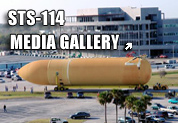 |  |  |  | 
The last Space Shuttle mission to land at Edwards Air Force Base, Calif., was STS-111 on June 19, 2002.

|  |  |
+ More NASA Facts...
|
|  |
|
 |
|  |
|  |
| Mission: International Space Station Flight LF1
Space Shuttle: Discovery
Launch Pad: 39B
Launched: July 26, 2005 at 10:39:00:07 a.m. EDT
Landing Site: Edwards Air Force Base, Calif.
Landing: Aug. 9, 2005 at 8:11:22 a.m. EDT
Duration: 13 days, 21 hours, 32 minutes, and 48 seconds
Orbital Insertion Altitude: 122 nautical miles
Orbit Inclination: 51.60°
STS-114: A Historic Journey
 On July 26, 2005, Space Shuttle Discovery launched into a clear blue sky on the historic Return to Flight mission, STS-114. On July 26, 2005, Space Shuttle Discovery launched into a clear blue sky on the historic Return to Flight mission, STS-114.
After a two-week, 5.8 million mile journey in space, the orbiter and its crew of seven astronauts landed Aug. 9 at California's Edwards Air Force Base.
Image above: Space Shuttle Discovery rockets into a bright blue sky from Kennedy Space Center's Launch Pad 39B. Below: After a successful landing at Edwards Air Force Base, Discovery returns to Kennedy attached to a Shuttle Carrier Aircraft. Image credit: NASA/KSC
 The final leg of Discovery's mission was a 2,500 mile ferry flight from Edwards to Kennedy Space Center. The final leg of Discovery's mission was a 2,500 mile ferry flight from Edwards to Kennedy Space Center.
Secured to the top of the Shuttle Carrier Aircraft, one of NASA's two modified Boeing 747 jets, Discovery returned to its home base with a landing at Kennedy's Shuttle Landing Facility Aug. 21.
Photo Galleries:
+ Launch Day Events
+ Landing Day
+ Discovery Returns to KSC
| |
|
 |
|  |
|  |
| 
| The World's Greatest Piggyback Ride
Two customized 747 aircraft have the critical job of carrying space shuttle orbiters across the country.
+ Read More
+ View Video (Real)
 | |
 |
| 
| A Spectacular Test Flight
The first of two Return to Flight missions, STS-114 featured several accomplishments and taught NASA some important lessons.
+ Read More
 | |
 |
| 
| Red Water Sausages?
Uncovering the mystery of the rose-colored rectangles below the Solid Rocket Boosters
+ Read More
 | |
 |
| + View Archives | |
|  |
|
|


